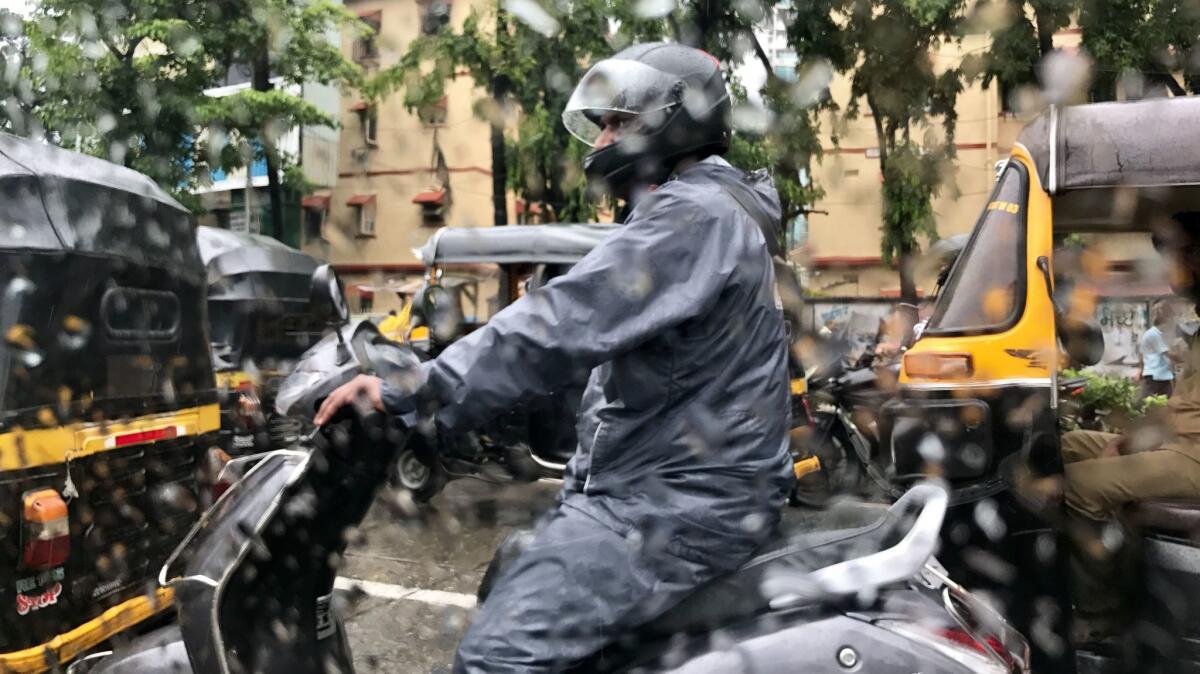On the Ground: How an L.A. native learned to stop worrying and love — OK, tolerate — India’s monsoon
Reporting from Mumbai, India — After the stultifying heat of April and May, Indians greet the onset of the annual monsoon like a long-lost relative, racing outside to be showered in its affections or gazing at it tenderly through a window while sipping hot tea.
This, at least, is the response of characters in movies and television commercials, which market the rainy season as a special, even romantic, time of year.
In reality, like many visiting relatives, the monsoon can disrupt routines, damage your stuff, surprise with its eccentricities, test your relationships and generally overstay its welcome. You’re not going to escape it; you just need to deal with it.
This is my fourth monsoon since moving to India. Growing up in L.A., rain was a rarity. Now it’s an entire season, and I still marvel at its power.
One moment you’re staring out the window into dappled sunlight, rays peeking through clouds and falling in flattering ways on the gently decaying high-rises of Mumbai. The next moment, the sky is dark, the wind is roaring and rain pellets are diving sideways into the glass like liquid kamikazes, coating the windows until you feel like you’re living in an aquarium.
I work from home, and usually I can observe the rains, which begin in June and last two to three months, from the (mostly) dry perch of the 10th-floor bedroom I use as an office.
When I need to venture out, or get caught in a storm (daily weather forecasts here are of little help in predicting times of heaviest rain), I can’t help but notice how this seaside city and its people swiftly retrofit themselves for the monsoon.
Drivers of three-wheeled rickshaws affix plastic tarps to the sides to keep water out of their carriages, then continue zipping across the sodden roads, honking as aggressively as ever. Toll-booth operators, landscapers and other civic workers don ponchos and go about their jobs, often in the same open-toed sandals they wear on dry days.
Even the runners and joggers who fill the Arabian seafront promenades — multi-generational, open-air gyms in a megacity notoriously starved for space — continue their morning workouts. A friend recently reported seeing the older, wealthier men of his neighborhood half-jogging with servants in tow, holding their umbrellas.
The monsoon is an entity, its arrival closely tracked for weeks by the newspapers, its volume and consistency crucial to the lives of hundreds of millions who depend on farm income. In the cities, the incoming rains are the only thing that seems to get the famously corrupt road contractors to complete their repairs on time.
When they finally come, the storms wash thick layers of smog from the skies and bring relief to overworked air conditioners and clattering ceiling fans.
The monsoon also is a cultural force in South Asia, the inspiration for centuries of art and literature, along with countless syrupy Bollywood songs and at least one movie about a wedding. In these more prosaic times, “monsoon” is a word used to advertise cellphone data plans, airline tickets and even the July-September session of India’s Parliament.
“Like the Monsoon brings hope, this session also brings same spirit of hope,” the office of Indian Prime Minister Narendra Modi tweeted this month.
I will admit to being less than charmed. The first year I lived in Mumbai, before my wife and I were married, I was looking to impress her with a quintessential monsoon getaway. A relative offered a family home in the hills three hours from Mumbai.
We drove up there under threatening skies, and no sooner had we put our bags down in the house than the thunder crackled, and rain began to fall in sheets. It was so thick that the view from the upstairs balcony that I remembered from childhood — a grove of stately trees rolling down a green slope — disappeared into a fog.
It poured like that for three days, finally stopping just as we were preparing to drive back to Mumbai.
Some Indians love this weather, finding it perfect for getting drenched by crashing waves or for dunking fried snacks into hot, milky tea.
I find the water an equal-opportunity destroyer, flooding train tracks and causing Uber fares to surge, seeping through roofs and windows in rich and poor homes alike.
In our last apartment, the rains produced so much moisture that my wife and I returned from a month away to find all her clothes covered in mold. Water leached from the balcony into the floorboards in our bedroom, warping the wood. Several weeks later, tiny white fungi poked through the cracks.

Still, the pleasure in the season seems to derive from the knowledge that it will soon be over, and the heat will return. The most common greeting you hear is not, “Staying dry?” It is, “Enjoying the rains?”
I am trying. This year, I have found a place where the showers seem more agreeable: a swimming pool tucked into the back of a hotel that faces a beach about a mile from our new apartment. Here, the droplets falling from the sky mean there’s no chance of dawdling on a lounger, and the storm whipping across the ocean feels bracing.
I went the other afternoon to find the pool empty of the usual gaggle of children finishing a morning lesson. The bank of lockers had been pulled out of the wall because of a damaged exhaust pipe, which workers blamed on the weekend’s rains.
There was just one other woman in the pool, struggling through a lesson, annoyed at the rain coating her pink goggles. Her coach was philosophical, splashing his hands in the overflowing pool.
“If not for the rain,” he said, “what will this water drink?”
She waded to the side, unimpressed.
I took a breath and let go of the wall, beginning a lap. With my head down, legs kicking, lungs pumping just below the water’s surface, I couldn’t even feel the rain.
Follow @SBengali on Twitter for more news from South Asia
More to Read
Sign up for Essential California
The most important California stories and recommendations in your inbox every morning.
You may occasionally receive promotional content from the Los Angeles Times.











